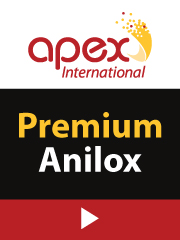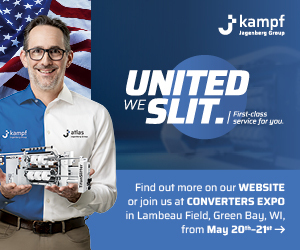UV letterpress assures quality at QA Label
- Published: August 01, 1995, By Simonsis, Yolanda
Building Quality Assured Label from the ground up meant a lot of sweat and some very good decisions, including the choice of ultraviolet letterpress equipment from Sanki.
What happens when you introduce a young offset printer to a former accountant? In the case of Joe Franko, the printer, and Bob Westmeyer, the accountant, the result is a company called Quality Assured Label, Inc. In operation for a little over 10 years, QA label has grown to become a highly successful label printer with customer names that read like a list of fortune 500 companies. Ultraviolet rotary letterpresses have helped the company achieve its success.
Joe Franko's father was a printer, so Joe grew up with ink in his veins. He started work at the age of 13 in a screen printing shop in Minnesota. After moving to California for another printing job, he returned to Minneapolis, started and closed an offset printing shop and ultimately interviewed for a job at a flexo label converter with former-accountant-turned-plant-manager Bob Westmeyer. With Westmeyer's accounting background in the packaging industry, his role in the subsidiary label operation ultimately led him to become vice president of sales. Franko, meanwhile, eventually worked himself into a sales position that once again permitted contact with Westmeyer. In 1984 they both left to form QA Label.
Choosing UV Letterpress to Deliver Quality
In starting out their new business, Westmeyer and Franko identified the pharmaceutical industry as a marketplace of opportunity for labels - if they could deliver the quality these jobs demanded. They believed that what was a newer process in the US at the time - UV letterpress - would provide the quality necessary, to compete successfully in this market.
The press that caught their eyes was Sanki's UV rotary letterpress. For the dollar they would have to invest, they felt no one could touch this press in terms of quality. The Sanki press was the first purchase for the new company and only the third such press sold in the US.
For nine long months they waited for their first job. During this time Joe and Bob re-evaluated the direction of the business. Potential clients expressed interest in the health and beauty aids market. So, the HBA market was where they turned their attention.
"We stayed in K.O.A.s across the country on our sales calls," recalls Westmeyer. "Joe and I drove small Hondas with no radios and no air conditioning. We would pull up to a campground, pitch our tent and the next morning we would emerge in three-piece suits ready for another day of sales calls. Meeting again that night at another prearranged campground, we would repeat the process and part the next day to sell again. We were both young and had a dream and really enjoyed what we were doing."
Success Brings More Presses
It was not long after that first nine months that they bought their second Sanki press. After it was installed, business really started to take off. They would work up to capacity on the new press, and, when they were forced to go to a second shift, they would then order another press. By 1988 they had installed six Sanki presses and were running three shifts.
QA had developed a reputation for some of the highest quality printed product available, as well as unsurpassed service.
Meanwhile, they continued to constantly experiment with new processes. Sanki, as well as other equipment manufacturers, worked with QA Label as a Beta site for these new processes. Franko and Westmeyer were developing their own equipment to a level they knew was necessary in order to give QA an edge in the marketplace. They purchased yet another Sanki and began adding screen and flexo capabilities.
By this time QA recognized a need to branch out. They selected Asheville, NC, for this purpose in 1992 to gain entrance into the HBA label business in the East. Today that plant operates four Sanki presses.
Growth was unswerving for QA. The next plant to open was in Phoenix, AZ, in January 1995, and, like the other plants, it included technology from Sanki UV rotary letterpress. Strategically placed, the Phoenix plant serves the West Coast and also gives QA access to the Mexican market. In order to feed these plants, QA opened sales offices in Chicago, Los Angeles, Cincinnati, New York and Mexico City.
Franko says, "It was not long before we began to run out of good press people. Since the local schools did not have suitable training programs, we decided to train our own press operators. We hire potential employees and make them general press workers for three months.
"If, after that three-month period, the new employees have the right recommendations from their supervisors, they can continue with their training. We then send them to our training center in Minneapolis for four months."
"During that period they receive extensive training in UV rotary letterpress on a Sanki press, becoming accomplished label printers. They operate the press, learning makeready and film production, and we teach them all about ink technology. After that four-month period, they are placed in one of our three plants."
Looking Back on a Good Choice
"We still feel," says Franko, "after 10 years, that our future success in producing quality labels lies in UV rotary letterpress. Sanki can lay down up to eight colors with perfect print-to-print registration running wide open. We get consistent solid line colors, plus fine lettering reproduction and clear halftones. It enables us to offer printing with full, uniform ink coverage and superior color consistency through the entire production run. We are in register within 12 feet with Sanki, whereas we have found that it takes over 100 feet on other presses.
"Simply by settling on Sanki as our only manufacturer of letterpress equipment," Franko continues, "we have gained greater flexibility. We can concentrate on the quality of our printing rather than having to train press operators in the idiosyncrasies of other presses. We feel that we take a back seat to nobody when it comes to quality."
An intensive quality control program has reduced rejects to less than 0.5%. Testing for cold, heat, steam and chemicals that attack the adhesive are just initial steps in the process. Testing of screen inks, cross hatching and ink laydown is also included, as well as tear testing and adhesive property testing.
In addition to QA's plant expansions, the firm has added a complete prepress department, giving them greater flexibility and enabling them to create and change film as needed.
While the quality of their equipment and process is key to their operation, Franko and Westmeyer also believe that the high level of success they have achieved is directly related to the level of expertise possessed by their employees.
"How we treat our people and how well we bring them along technically have a direct correlation to our success. From the pressroom to the rewind department, care is taken at QA to ensure the same high quality that was the goal behind our founding the company nearly 11 years ago," says Westmeyer.












